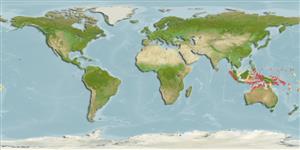Common names from other countries
>
Gobiiformes (Gobies) >
Gobiidae (Gobies) > Gobiinae
Etymology: Eviota: No etymology given, suggested by Christopher Scharpt: from Latin 'eu' for 'true' and 'iota' for anything very small, in combination 'truly very small' referring to it as being the smallest vertebrate at the time it has benn described by Jenkins (thus, making the suggestion by Scharpt plausible..
Environment: milieu / climate zone / depth range / distribution range
Ökologie
seewasser riff-verbunden; tiefenbereich 3 - 20 m (Ref. 90102). Tropical; 8°N - 18°S
Western Pacific: Japan, Palau, Federated States of Micronesia, Guam and Northern Mariana Islands, Vietnam, Indonesia; south to Rowley Shoals in the Timor Sea, Papua New Guinea, and Solomon Islands.
Size / Gewicht / Alter
Maturity: Lm ? range ? - ? cm
Max length : 2.1 cm SL Männchen/unbestimmt; (Ref. 1602)
Rückenflossenstacheln (insgesamt) : 7; Rückenflossenweichstrahlen (insgesamt) : 7 - 9; Afterflossenstacheln: 1; Afterflossenweichstrahlen: 6 - 7. Characterized by dark purplish brown body color with three white spots anteriorly on middle of side; presence of series of small white spots beginning on nape, continuing along base of dorsal fin and ending on dorsal surface of caudal peduncle; caudal fin base with red-edged black spot; iris reddish; first four dorsal spines elongate or filamentous in male; all pectoral rays unbranched; longitudinal scale series 21-23; ctenoid scales, absent on head, nape and pectoral fin base; separated pelvic fins, thin membrane joining bases; well developed fifth pelvic ray, 50-70% length of fourth ray; 3-6 branches of fourth pelvic ray; depth of body 3.6-5.0 in SL (Ref. 90102).
Inhabits silty sheltered reefs (Ref. 1602). Reported to be associated with the mushroom Heliofungia actiniformis (Ref. 91291).
Life cycle and mating behavior
Maturities | Fortpflanzung | Spawnings | Egg(s) | Fecundities | Larven
Myers, R.F., 1991. Micronesian reef fishes. Second Ed. Coral Graphics, Barrigada, Guam. 298 p. (Ref. 1602)
IUCN Rote Liste Status (Ref. 130435)
CITES (Ref. 128078)
Not Evaluated
Bedrohung für Menschen
Harmless
Nutzung durch Menschen
Tools
Zusatzinformationen
Download XML
Internet Quellen
Estimates based on models
Preferred temperature (Ref.
115969): 27.6 - 29.4, mean 28.8 (based on 934 cells).
Phylogenetic diversity index (Ref.
82804): PD
50 = 0.5000 [Uniqueness, from 0.5 = low to 2.0 = high].
Bayesian length-weight: a=0.00708 (0.00333 - 0.01504), b=3.09 (2.92 - 3.26), in cm Total Length, based on LWR estimates for this (Sub)family-body shape (Ref.
93245).
Trophic level (Ref.
69278): 3.1 ±0.3 se; based on size and trophs of closest relatives
Widerstandsfähigkeit (Ref.
120179): hoch, Verdopplung der Population dauert weniger als 15 Monate. (Preliminary K or Fecundity.).
Fishing Vulnerability (Ref.
59153): Low vulnerability (10 of 100).
